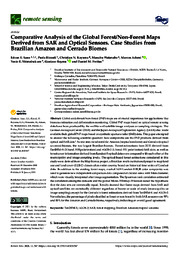Comparative analysis of the global forest/non-forest maps derived from SAR and optical sensors: case studies from brazilian Amazon and Cerrado biomes.
Comparative analysis of the global forest/non-forest maps derived from SAR and optical sensors: case studies from brazilian Amazon and Cerrado biomes.
Author(s): SANO, E. E.; RIZZOLI, P.; KOYAMA, C. N.; WATANABE, M.; ADAMI, M.; SHIMABUKURO, Y. E.; SILVA, G. B. S. da; FREITAS, D. M. de
Summary: Abstract: Global-scale forest/non-forest (FNF) maps are of crucial importance for applications like biomass estimation and deforestation monitoring. Global FNF maps based on optical remote sensing data have been produced by the wall-to-wall satellite image analyses or sampling strategies. The German Aerospace Center (DLR) and the Japan Aerospace Exploration Agency (JAXA) also made available their global FNF maps based on synthetic aperture radar (SAR) data. This paper attempted to answer the following scientific question: how comparable are the FNF products derived from optical and SAR data? As test sites we selected the Amazon (tropical rainforest) and Cerrado (tropical savanna) biomes, the two largest Brazilian biomes. Forest estimations from 2015 derived from TanDEM-X (X band; HH polarization) and ALOS-2 (L band; HV polarization) SAR data, as well as forest cover information derived from Landsat 8 optical data were compared with each other at the municipality and image sampling levels. The optical-based forest estimations considered in this study were derived from the MapBiomas project, a Brazilian multi-institutional project to map land use and land cover (LULC) classes of an entire country based on historical time series of Landsat data. In addition to the existing forest maps, a set of 1619 Landsat 8 RGB color composites was used to generate new independent comparison data composed of circular areas with 5-km diameter, which were visually interpreted after image segmentation. The Spearman rank correlation estimated the correlation among the data sets and the paired Mann–Whitney–Wilcoxon tested the hypothesis that the data sets are statistically equal. Results showed that forest maps derived from SAR and optical satellites are statistically different regardless of biome or scale of study (municipality or image sampling), except for the Cerrado´s forest estimations derived from TanDEM-X and ALOS-2. Nevertheless, the percentage of pixels classified as forest or non-forest by both SAR sensors were 90% and 80% for the Amazon and Cerrado biome, respectively, indicating an overall good agreement.
Publication year: 2021
Types of publication: Journal article
Unit: Embrapa Cerrados
Keywords: ALOS-2, Cerrado, Floresta Tropical, Forest mapping, Mapa, Remote sensing, SAR, Savannas, Sensoriamento Remoto, TanDEM-X, Tropical forests
Observation
Some of Embrapa's publications are published as ePub files. To read them, use or download one of the following free software options to your computer or mobile device. Android: Google Play Books; IOS: iBooks; Windows and Linux: Calibre.
Access other publications
Access the Agricultural Research Database (BDPA) to consult Embrapa's full library collection and records.
Visit Embrapa Bookstore to purchase books and other publications sold by Embrapa.

